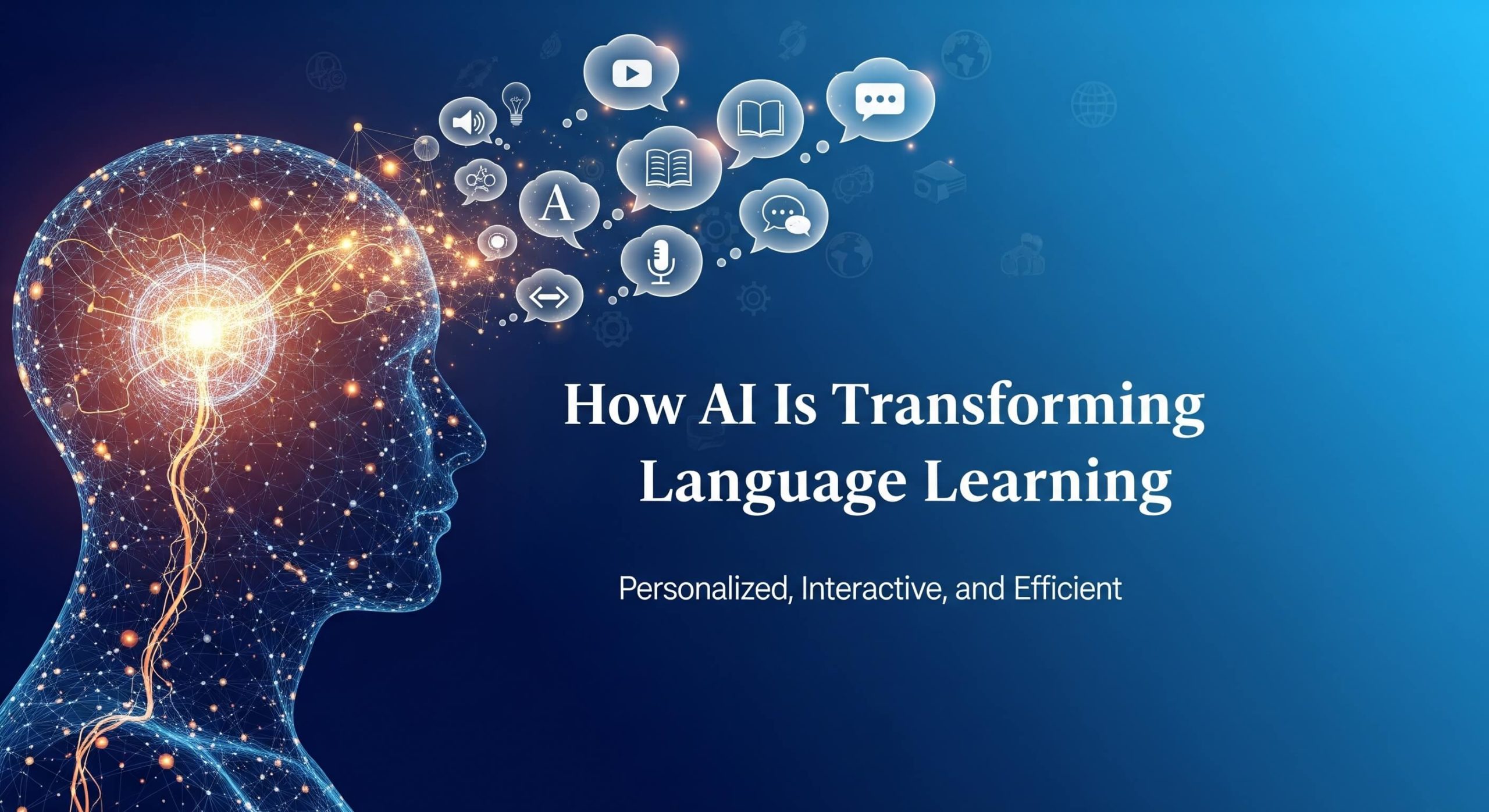
AI has infiltrated almost all areas of contemporary business, but in one field, there is an abnormally steep increase in practical application: language teaching. Over a billion individuals are learning English nowadays, and they are no longer content with a textbook or a video they watched earlier. They desire reactivity in their dialogue, hyper individualization in their training, and quantifiable outcomes that can be easily squeezed into slots between morning messages and night workouts.
That is exactly what AI provides. In the following lines, we discuss why investors, founders, and corporate training leaders view english for beginners as a playground of leading-edge machine learning, a perfect sandbox where pedagogy and data are combined in large quantities. We open up what technologies are the most important, how the new tools transform teaching and learning, and where the greatest opportunities and risks are in the rest of the decade. The emphasis is down-to-earth, the style is business-like, and the future is up to 2030. In the final paragraph, you will feel where to put your bets, be it your money, time or workforce.
The Market Signals Are Loud and Clear
The world has an unofficial international operating system, which is the English language. In 2025, the number of all people speaking English as a native or second language is about 1.5 billion. In recent years, the market size of digital language learning has increased exponentially. It is expected to increase by 21.5% in the compound annual growth rate (CAGR), increasing to the value of $36.01 billion in 2025 as compared to the value of $29.64 billion in 2024 .
Three macro-drivers explain the surge:
- Globalized talent competition. Cross-border remote work is normal, so English fluency is no longer optional for many roles.
- Mobile-first emerging economies. First-time learners have instant access to courses and micro-lessons using Smartphones.
- AI-enabled personalization. Adaptive engines enable the one-to-many courses to act as one-on-one tutoring at last.
For investors, startup founders, and corporate L&D managers, ignoring AI in language learning is now a competitive risk, not just a missed opportunity.
What “AI” Actually Means in Today’s Language Apps
To avoid buzzword burnout, let’s unpack the specific technologies powering the new generation of English-learning products:
| AI Capability | Core Techniques (2025) | Practical Outcome for Beginners |
| Adaptive practice | Reinforcement learning, Bayesian knowledge tracing | Tailor’s difficulty in real time, preventing cognitive overload |
| Speech recognition and synthesis | Self-supervised acoustic models, neural TTS | Instant feedback on pronunciation; natural “teacher” voices |
| Computer vision | Lip-reading networks, AR overlays | Helps learners align mouth movements and phonetics |
| Large Language Models (LLMs) | GPT-4-Turbo/, Claude, Gemini | 24/7 conversational partners, dynamic explanations, grammar corrections |
| Emotion and engagement analytics | Multimodal sentiment detection | Detects boredom or confusion; adjusts lesson pacing |
When these modules are interwoven into one platform, what you end up with is like a patient, bilingual tutor who sleeps not and costs less than a latte a week.
From Static Curricula to Hyper-Personal Roadmaps
Conventional entry-level courses go in a straight line. All the students are introduced to the alphabet on Monday, and the verb to be on Tuesday, and so on. That schedule is ripped apart by AI. During onboarding, the writing and speaking are sampled by a diagnostic test.
The outcomes are used to feed a learner profile which informs all subsequent exercises. In case a user already knows basic greetings and has difficulties with articles, the system promotes specific article drills a few minutes into the first session.
Then spaced-repetition algorithms predict when each new word is likely to slip out of memory and bring it back to review. The impact is impressive: retention skyrockets, motivation increases, and adults with a limited amount of time in their lives feel that they are making progress, not fighting against lectures.
Conversational AI Becomes a Real Tutor
Chatbots of the earlier days were mere choose-your-own-adventure programs. The new LLMs are a new breed. They engage in free-domain conversation concerning the market rally of yesterday or the football game of last weekend without losing the accuracy of grammar. They act: an immigration official, or a venture capitalist, or a friendly barista, and add the jargon and cultural signals each circumstance requires. In a similar way, a speech writer ai can generate context-aware scripts, helping learners practice real-world communication scenarios.
They also provide layered feedback. A learner who writes, He went yesterday, may be corrected by being told in a polite way the correction, and then have a brief reminder about the conjugation of the past tense, and then a brief fill-in-the-blank assignment to fix the form. All this is happening within a single-threaded interaction, which makes the difference between the error and mastery only several seconds. The rate of completion increases since the discussion does not feel like it is staged.
Pronunciation Tools Break the Plateau
The place where self-study goes awry is usually pronunciation. Students can learn the grammar rules and yet fear to speak, fearing that they may not be understood. AI assaults the issue on various levels. Advanced acoustic models rate every phoneme against millions of native standards, not only pointing out that something was wrong but precisely which mouth position led to the lapse.
Computer-vision overlays allow the learner to record a short video and then overlay a see-through guide on their lips to indicate the correct position of the tongue and the jaw. Others even repeat the sentence of the learner with a standard accent and provide an auditory model to be imitated instantly. Since the analysis occurs locally on current smartphones, the feedback returns within a quarter of a second, quicker than it takes to remain within the natural rhythm of practice.
Curriculum Generation at Machine Speed
It used to cost a lot to produce graded reading passages or grammar drills with human writers. These days, AI does the heavy lifting.
- Topic scraping. The system draws on the trending keywords (e.g., quantum chips, inflation data) so that vocabulary does not feel outdated.
- Checking of CEFR alignment. Custom classifiers check that the texts comply with word-frequency ceilings at A1/A2 levels.
- Auto generation of distractors. The wrong answers on multiple choice questions are created so that they are realistic and wrong, and this is a tedious task.
OpenAI GPT-4 API saves time in the content creation cycle of publishers. The money can be reinvested in human quality control and multimedia assets.
Data-Driven Pedagogy for Teachers and Corporates
AI doesn’t replace language teachers; it changes their job description:
1. Actionable dashboards highlight which students struggle with past tense irregulars versus pronunciation of /θ/. Teachers can assign micro-homework instead of guessing.
2. Predictive dropout alerts. K-nearest neighbor models flag learners likely to churn within a week, allowing proactive intervention.
3. Automated assessment. IELTS or TOEFL-style writing tasks receive AI-first scoring. Human examiners then spot-check borderline cases, doubling throughput.
For startups selling B2B licenses, these analytics are the sticky moat decision makers crave.
Future Outlook
Edge computing will allow smaller language models to run offline shortly and allow feedback loops to continue during long flights or in rural locations. Spatial-computing headsets will bring the promise of virtual immersive cafes, airports, and boardrooms where novices can practice actual interactions without leaving the house. The line between practice and live commerce will become blurred because automatic simultaneous interpretation, which has already been demoed in video-conferencing platforms, will be able to provide a seamless experience.
As the technologies mature, employers will be less interested in one-shot test scores and more interested in dynamic portfolios of competence recorded by AI on real work tasks. The conclusion is obvious: adoption will intensify, use cases will multiply, and the market leaders will be those who can combine pedagogy, data ethics, and solid engineering into a single roof.
Conclusion
Artificial intelligence has already achieved a maturity stage where it can address the most challenging aspects of beginner-level English: individualized pace, low-cost speaking training, and immediate corrective feedback. This is a growing market, and the entrepreneurs have an opportunity to create new niches and healthy margins. To the corporations, it is a means of future-proofing a multilingual workforce without blowing up the training budget. To learners, it implies quicker advances and more assurance. The first ones to grasp the tools will discover that English is no longer a barrier but a launching pad into the world discussions that count the most.




